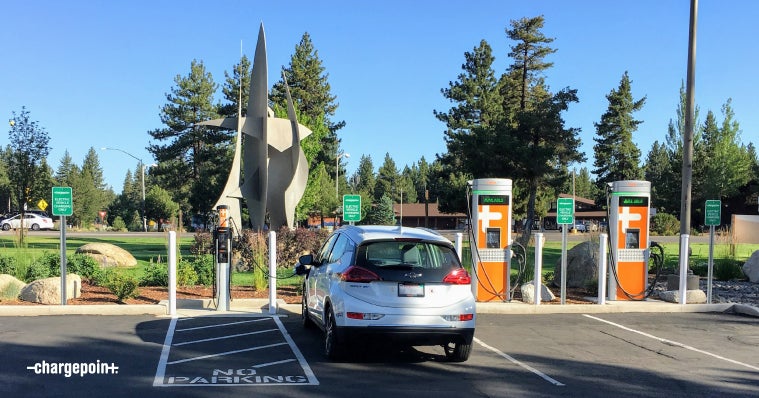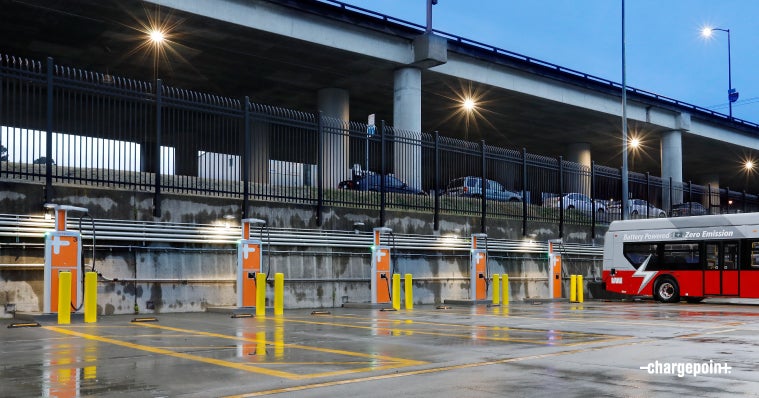
In November 2021, President Biden signed the bipartisan Infrastructure Investment and Jobs Act (IIJA) into law, which commits to investing $5 billion in electric vehicle (EV) charging infrastructure. In the months since, ChargePoint has been engaging policymakers and sharing best practices to ensure that these federal investments will work as well as possible.
The IIJA creates the National Electric Vehicle Infrastructure (NEVI) Formula Program, which will allocate funding to states and territories to support the deployment of EV charging stations along highway corridors. Federal officials have said they expect funds will start flowing to states in the coming months. Right now, federal agencies are developing regulations that will serve as the “rules of the road” for how states use these funds, informed in part by their experience with federal fleet electrification.
More than a decade of experience installing EV charging and shaping infrastructure incentive programs has given ChargePoint unparalleled insights about where EV charging is used most. As the May 13 deadline for publishing of minimum standards and requirements for program-eligible EV charging equipment nears, here are nine key considerations about highway corridor EV charging that we think can inform this new national grant program.
-
Where should EV chargers be placed?
Every state is unique in terms of its current status of infrastructure buildout, the locations of major cities and destination centers, and the needs of EV drivers. Therefore, states should determine the appropriate distance between charging locations along highway corridors and prioritize convenience and accessibility to both long-distance drivers and the local community. Siting guidance should offer flexibility in high-traffic areas, which may need more charging locations, and more rural areas, which may need fewer. In addition, states could expand access for drivers by enabling funding to build additional chargers at locations that already have existing EV charging infrastructure and high utilization.
-
How should EV chargers connect to the electric grid and work with renewable energy sources?
Flexibility is key. Charging station operators should be able to choose the energy management and smart charging tools that best suit their on-site needs and the needs of their communities. Not every location is equally suited for renewable power, so states should be able to encourage the use of renewable energy or on-site storage when selecting projects, but these features should not be required as doing so could limit access to charging in certain locations.
-
What are the best off-highway locations?
Most DC fast chargers (DCFC) can add 100+ miles of range in under 30 minutes, making them well suited for locations where drivers will spend less than an hour. Fueling centers, small businesses, retail establishments, grocery stores and similar locations can be a good fit for fast charging. At charging locations, drivers should have a sense of safety and be able to access amenities, such as bathrooms and food, while charging. Ideally, chargers should be located within a mile of a highway exit, but flexibility should be given in areas with limited site options.
-
What are the best ways to ensure EV charging is available in rural corridors and underserved communities?
Electric mobility should be attainable for everyone. The federal government can help achieve that goal by reserving a large portion of the funding for rural and underserved communities, making individual EV ownership more feasible for more people. We also know that not everyone has access to a personal vehicle. Whether someone takes the bus, uses a rideshare service or drives a work vehicle, they should have the opportunity to choose electric. That means we need complementary policies and programs to support fleet charging for transit, rideshare companies and freight operations.

-
How can we ensure publicly available EV chargers are maintained and in operation for the long term?
EV chargers are critical infrastructure that must be reliable for drivers, operators and communities over time. The federal government should require EV charging operators to commit to minimum operational uptime requirements, measured on an annual basis. To troubleshoot any issues, charging networks should provide 24/7 driver support.
-
What are the best ways to leverage existing private, national, state, local, tribal and territorial government EV charging infrastructure programs and incentives?
Many states, local governments, utilities, tribal and territorial governments already have EV charging infrastructure grant programs or incentives, and those who want to build out EV charging infrastructure should be enabled to combine available incentives to support project development. Safeguards should be set up so government incentives are never combined to exceed 100% of project costs.
-
How can private funds be leveraged to maximize EV charging infrastructure?
For more than a decade, businesses seeking to attract EV drivers as their customers, residents or employees have been investing private capital to build and operate charging infrastructure. These businesses have found that investing in charging creates a stream of revenue to manage energy costs, maintain the charging infrastructure and add more chargers as driver utilization increases over time. The NEVI funds can accelerate the buildout of charging across the country by enabling these businesses looking to install chargers to be eligible for funding. By combining private investment and public grants, more chargers will be built in more places, benefiting EV drivers everywhere.
-
How can EV charging infrastructure power levels and charging speeds meet current and anticipated market demands and minimize charging time?
States should have the flexibility to determine appropriate power levels for corridor chargers based on site conditions, driver needs and operating costs. DC fast charger power levels should be determined by assessing what is suitable for the location and take into account sites that lack access to power, the cost of electricity and the expected utilization of the chargers.
Most importantly, charging locations should be “future-proofed” with initial infrastructure built to accommodate installing additional chargers in the future without more major construction. Charging sites should also feature at least one CHAdeMO connector to support older models of EVs that are still on the road today.
-
Are there other factors that should be considered in funding EV charging infrastructure?
Charging infrastructure should accept multiple payment options, including mobile and contactless credit cards, and support the ability to use other charging network memberships through roaming agreements. This will ensure secure and convenient access for all drivers now and in the future.
These are just a few of the pieces of advice ChargePoint is sharing to help ensure the federal government’s $5 billion investment in EV charging infrastructure works as well as possible for all EV drivers, businesses and fleets alike. We’re proud to advocate for electric mobility and confident that these funds will help build out infrastructure that will ease the transition to electric for everyone.
